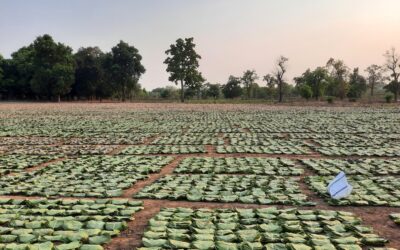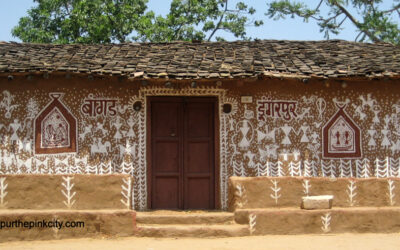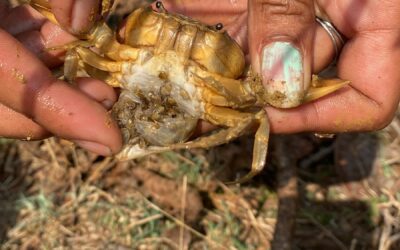During the one year I spent in Himachal Pradesh, I met several people, during workshops, at my organization or while traveling. Two people who frequented Kandbari are Vikram and Apoorva. What’s interesting about them, you might ask. For starters, they are a cheerful couple living their dream. Every interaction with them has taught me something new. I spent one quiet Sunday morning in their company with mouth watering aloo pyaaz parathas and generous dollops of butter at their quaint house in the hills, in order to unearth their story.

Vikram is from Himachal and has spent all of his adolescent life in the hills. As a child, he felt schooling was mundane. It did not excite him. He inadvertently chose botany in college to eliminate studying Math. In hindsight, he says that it has helped him a lot in classification. But he had an eccentric hobby that came to him as naturally as breathing.
“Nobody taught me to collect and store things. I started doing it on my own since the age of eight.”
His room is filled with collectibles and he has always had a knack for it. He has collected at least a hundred hair clips! A little unusual to find so many of them when none has been purchased. “I just found them,” he says with an air of nonchalance. “If I walk down the road for 2 km to the highway, I might find ten more.” Other unusual finds include a collection of pen caps, matchbox covers and assorted bottle caps. He even houses an unread stack of fictional books that he has collected over time. This habit has translated into collecting creatures from nature as well. Whenever he finds any life form, his mind weaves stories around how it must have reached where it is and his innate curiosity helps him inspect in detail.
Apoorva has spent most of her life in the city. After graduating from college, she found her calling in the field of education. Both of them enjoyed the perks of a corporate life at some point in their lives. Even while Vikram was away from the vast biodiversity hub, Himachal Pradesh, he went down to Sukhna lake in Chandigarh on weekends. Working inside glass doors, he collected insects who wanted to escape but would lose their lives on striking the glass. Back then he hadn’t thought of setting up a biodiversity museum and sharing it with a large group of people.
Initial Days
Their paths intersected at Aavishkaar, an organization working to incorporate scientific temper in students of our education system. While Vikram’s friends know about his passion for biodiversity, his hobby over the years had created a treasure that only a few had known. When Apoorva discovered it, she was astonished as the specimens she knew about only scratched the surface. She encouraged him to organize his collection and build a career out of it.
As a first step, they conducted an impromptu session with kids at a residential summer camp in May 2017. These insects and their habitats found their first set of admirers after 17 years Vikram had collected them. For shaping his passion project further, he started his own journey in September 2017. Both of them continued brainstorming for ideas. A seamless combination of his photography skills and ongoing biodiversity expeditions gave birth to Life Meets the Lens in October 2017. It created an opportunity for all nature lovers to get together in a small group for three days and document natural ecosystems through field trips that are quite an eye opener. It was a way to develop an appreciation for all the varied life forms we share our planet with.
Behind The Scenes
Every day is different and their schedules are dynamic. They plan their day on the go but are always prepared with their gear - empty boxes to store any specimen found and a camera. When they have fellow naturalists visiting them or beginners coming to learn, they spend at least five hours a day outdoors, filming and documenting their findings. Their latest project involves working with local kids. Vikram returned to his homeland only to realize that the children were leading the same lifestyles as they did in the 1980s. A day in their lives includes frolicking by the riverside (locally known as khadd), walking to the school, scrounging wild berries from the bushes, and playing gilli danda. Their fearlessness remained unchanged too. Kids do not care about trespassing unknown territories while having fun. They will tread on puddles and pass through areas where adults might think twice. Armed with a camera, these gutsy battalions would exponentially increase the outreach and mission of documenting more species.
Observing the current trend in this village indicates that children and youngsters migrate to cities to go to college and find well paying jobs. An endeavor that offers an interaction with their local resources could potentially make them study more about it and turn their favorite pastime into a career. After spending considerable time in the education sector, the duos’ excitement for working with kids doesn’t come as a surprise. However, they do not call themselves change makers. One of their objectives is to sensitize people and sharing knowledge acquired over the years. They believe that once you have understood your options, the choice lies on your conscience.
A Peek Into The Collection
“This is our latest collection,” he said like one of the designers presenting their latest fashion creations for the season. Here it meant an assortment of creatures and their homes. I asked him to share three of those.
First Find

A beetle commonly found in rice and wheat flour (atta). He got it while his mother was cleaning rice. He took different colored beetles and put them in a separate jar of rice to observe for the next eight to ten months. Luckily, we found one immediately in his kitchen. On asking about how does he still have specimens from several years ago, led to a conversation about the difference between storage and preservation. Preservation is when a specimen has all its bodily fluids intact and it is submersed in a solution to prevent decay. Most of Vikram’s samples are stored in transparent boxes with Naphthalene balls to prevent the growth of fungus. With experience, he has learned to estimate the weight of anything that he finds when it’s devoid of its bodily fluids.
Luckiest Find: Morchella mushrooms, locally known as guchchi, are found at high altitudes. These mushrooms are not usually cultivated. They flourish on their own in a span of twenty-hours when it rains and the humidity as well as other climatic conditions are ideal for it. About four months ago, he unexpectedly found them near his home. These mushrooms are gorgeous to look. They camouflage within leaves and stones which makes them harder to spot.

A troop of Morchella mushrooms (Image credit: Vikram Singh)
Favourite Find: This was equivalent to asking a mother who their favorite child is. He could not pick one obviously. But he loves showing off his bee and wasp homes and skulls to as many people as possible.

Some of the hives. Can you identify whether they belong to a bee or a wasp?
My first glimpse into the world of ‘Life Meets the Lens’ was in January 2019. At that time, I was surprised that I had never noticed all the beautiful bees and birds I was surrounded with. With my heightened sense of newfound awareness, I consciously paid attention to them and noticed that they can be found in large numbers everywhere. I had neglected them all this while co-existing with them.
Vikram interjected at the use of neglect. He took me way back in time to 1660s and made me imagine the kind of lifestyle humans led over three centuries ago. Survival and protection were the two prime responsibilities. They were scarcely surrounded with man-made objects. Even houses were a lot different. Reliance on nature was immense, also for gathering food. This close association with the environment made man aware about what is friendly and what is not. Today we are supplied with packaged food from convenience stores. We have built sturdy houses to shelter ourselves and we travel around on wheels. Understanding our surroundings is a choice rather than the key to survival. We have conditioned to make our lives better by decorating our homes or ourselves. Other species continue to thrive on the same principles of survive and protect even today.
Windows need curtains, beds need mattresses and cushions, a room needs lights but nature does not ask for supplementary accessories. Vikram admires how everything found in nature is self sustaining. The freedom to explore without being watched or trespassing someone’s property can pose as a challenge. Sometimes it is hard to convince people with facts because of widely held misconceptions.
Often kids attending the workshop firmly believe that insects that are unusual in appearance were created to attack humans, which is not the case.
Over The Years
‘Life Meets the Lens’ is creating awareness by sharing that a lot of species exist in nature through their specimens. Plenty of organizations in the country are working on wildlife conservation and biodiversity using different means. Some of them are striving to save endangered species by spreading awareness about their role in the ecosystem. A lot of this work is academic when it comes to NCBS or WWF. Vikram and Apoorva haven’t met any hardcore naturalists in India yet but they are open to collaborations with authentic organizations and individuals for their citizen scientists project.
Museums caught Vikram’s fancy while studying in college. He wanted to create his own space to showcase his collections where people visit like any other museum. Three years hence, hopefully Kandbari’s first biodiversity museum will be open for public and people will have developed a fair understanding of a naturalist’s work. It will be a hub for everyone across the world to share specimens from lands far off and cross-reference with the existing exhibits in the museum. It might help to identify and name new species. People of all ages would be welcome to share their ideas and learn from each other.
A Spectacle In The Balcony

Can you spot the caterpillar on this plant? On closer inspection, the brown appendage to the stem is not a twig but a caterpillar.

Tiny tadpoles in the balcony at various stages of their life.
Their balcony is an attempt of getting closer to nature at home. Kids often ask questions about the life cycle of a tadpole. Instead of fetching answers from books and the internet, Vikram has created mini ecosystem to foster tadpoles and gather insights through their different stages. When they mature into frogs, they are left where they belong.

Does this look like an insect? Well, it was. Now it’s just the outer covering (or exoskeleton) of a cicada that it has left behind. Pretty much like a snake shedding its skin.

This is the eye of a housefly magnified 60 times! It’s a common fact that housefly has compound eyes , meaning two eyes but thousands of lens.
We live in a world of choices and with the bountiful options people have to build their careers, making a choice can be overwhelming. I asked Vikram to share his thoughts on it because he has followed the convention and walked away from it to start his own venture. He says that it might seem like a generic advice but do what makes you happy. If given the choice to do anything else, you would still want to follow your choice if your happiness lies in it and others’ opinions will scarcely make a difference. When you’re sure about your idea, you don’t seek validation from others. It doesn’t matter whether the world tells you it’s possible or not. You believe in the idea to its core. Do not hesitate before taking the off beat path if the idea speaks to you. But taking a lesser explored career because it’s trendy sends the wrong message. When you do it, it’s the easiest thing because you carve your own identity and there isn’t an image to uphold.
If you enjoyed reading this blog, check out David Attenbourough’s work and The Amateur Naturalist by Gerald and Lee Durrell.




Thank you 🙂
nice presentation …